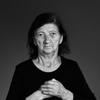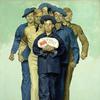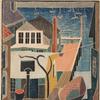Ruby City to present Tangible/Nothing beginning September 8
- SAN ANTONIO, Texas
- /
- August 19, 2022
Ruby City will present Tangible/Nothing, a new installation of its permanent collection galleries, September 8, 2022, through April 30, 2023. The exhibition will feature approximately 40 works by national and international artists as well as those with San Antonio and Texas ties, including recent acquisitions on view for the first time. Tangible/Nothing explores how the invisible or the seemingly mundane can reveal great meaning. Some works represent apparent voids, vestiges of what’s missing or subjects not pictured– a pair of arms bereft of a body, a woman represented only by her purse or Miss America seen only as a floating crown. Other works represent or incorporate everyday objects that stand in for big ideas, such as empty paint cans representing a white, heroic vision of America’s history or a bright pink stove calling out the pervasiveness of traditional gender roles.
“Tangible/Nothing speaks to two different artistic approaches used by many artists today,” said Elyse A. Gonzales, director of Ruby City. “The first is the removal or purposeful avoidance of selected objects, while the other makes use of commonplace things, sometimes even representing them. Tangible/Nothing demonstrates how artists have used these methods to great effect to address loss, identity, gender, history, environmental concerns— or to question the very nature of art. It was fascinating to see how these alternative ideas of ubiquity and absence factored into many works in the collection considering they have shaped so much of my thinking about our late founder Linda Pace and her legacy, here and beyond.”
San Antonio artists represented include Nate Cassie, Katie Pell, Chuck Ramirez and Juan Miguel Ramos. The exhibition also includes works by Alejandro Diaz (born in San Antonio, based in New York), Rick Lowe (Houston), Dario Robleto (Houston) and Adam Schreiber (San Marcos), as well as works by David Avalos, David Cabrera, Nathan Carter, Willie Cole, Dorothy Cross, Milagros de la Torre, Thomas Demand, Willie Doherty, Sam Durant, Kate Ericson and Mel Ziegler, Teresita Fernández, Michel Francois, Isa Genzken, Mona Hatoum, Sir Isaac Julian, Nina Katchadourian, Iñigo Manglano-Ovalle, Daniel Joseph Martinez, Adam McEwen, Yasumasa Morimura, Michael O’Malley, Gabriel Orozco, Cornelia Parker, Ruben Ortiz-Torres and Jim Mendiola, Paul Pfeiffer, Doris Salcedo, and Rikrit Tiravanija, among others.
Curated by Gonzales, the exhibition was inspired in part by Linda Pace, the founder of the Linda Pace Foundation and a lifelong supporter of artists. Though deceased in 2007, Pace and her legacy still deeply resonate throughout the Ruby City campus, its mission and the art community as a whole. The exhibition’s themes also reflect the social isolation caused by caused by the COVID-19 pandemic.
“Tangible/Nothing taps into our collective experience of absence and presence over the past two years when the physical separation from family and friends necessitated finding all manner of ways to connect with them in absentia—with many experiencing permanent loss,” said Gonzales.
Serving as the connective tissue of the exhibition are a series of works by artists, many of whom were friends, that intimately portray or memorialize Pace, even if she is not pictured. For example, Chuck Ramirez photographed Pace’s purse in Purse Portraits: Louis (Linda), 2005. Ramirez’s series of purses, seen from above with the contents exposed, represent the owners, since purses—and the objects carried within—are a most personal possession and constant companion of many women. Another example is BookPace (2002), a series of photographs of the book spines in Pace’s home library by Nina Katchadourian, on loan from the artist. Selected and arranged by the artist, the book titles become spontaneous sentences, poems that reveal Pace and her passions, known and unknown.
In the c-print Candles Un-burn, Suns Un-shine, Death Un-dies, 2010, Dario Robleto memorializes vinyl records and the wonder of “astronomical photography of the 1970s and 80s” as he states. Robleto removed all the figures in several “live” albums by deceased musicians such as Patsy Cline, Marvin Gaye and Bob Marley leaving only the stage lights. Combining these lights all together, Robleto’s image appears as though a glimpse of the universe.
Paul Pfeiffer’s video work Miss America (2003) includes an altered clip from the broadcast of the Miss America pageant. It shows only the bobbing crown moving on the stage, the beauty queen herself absent. Another work by Pfeiffer, Red Background #2 (2002), is a photograph of a red velvet background, typically used in commercial photography to advertise a product. Here, those objects are removed, leaving only the sumptuous fabric on view.
Rick Lowe’s Untitled (2021) a recent acquisition on view for the first time, is an abstract pattern based on the game of dominoes. The painting with collaged elements represents the artist’s personal experience with the game as well as the spirt of community that the game engenders and the places it is played. Lowe is currently featured in the 2022 Whitney Biennial. Similarly, Bitchen Stove (2006), by popular San Antonio artist Katie Pell (1965–2019), transforms an otherwise commonplace appliance—a gas stove—into a comment on the conservative expectations that are still leveled at women —the bright pink stove is customized like a lowrider car.
Kate Ericson (1955-1995) and Mel Ziegler are known for their conceptual works commenting on American history and its tropes. Their work High Gloss (1991), recently gifted to Ruby City, is a group of 80 empty paint cans, the dried colors still visible. The paint is from a line of housepaint from one of Benjamin Moore’s historic series. The colors are named for places and figures from the 18th and 19th centuries—stand-ins for broad, romanticized concepts of US history that privileged a white, male and heroic narrative.
Also on view will be Abstract Painting, White, Number 862 (2005), an all-white canvas by Daniel Joseph Martinez (who is also currently featured in the 2022 Whitney Biennial). Only the accompanying label suggests the subject of the work, the role (or lack of a role) of the state in higher human culture, typical of the artist’s abstract explorations of individual and collective identity.
Related Programs
Ruby City will celebrate the exhibition with a free public opening reception on Friday, September 9, 2022, 5–8 pm, with a walkthrough featuring Gonzales and selected artists at 5:30pm that evening. Other programs will include a family day on October 15 and a talk by artist Rick Lowe, in conversation with Gonzales, on November 10. Tangible/Nothing will remain on view through April 30, 2023.
150 Camp Street
San Antonio, Texas
info@rubycity.org
2102278400
https://www.rubycity.org/
About Ruby City
Ruby City is a contemporary art center in San Antonio, TX, dedicated to providing a space for the city’s thriving creative community to experience works by both local and internationally acclaimed artists. Envisioned in 2007 by the late collector, philanthropist and artist Linda Pace, Ruby City presents works from the Linda Pace Foundation Collection of more than 900 paintings, sculptures, installations and video works. The new building, designed by renowned architect Sir David Adjaye OBE, is part of a campus, which also includes Chris Park, a one-acre public green space named in memory of Pace’s son, and Studio, an auxiliary exhibition space which presents curated shows and programming throughout the year.
















